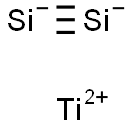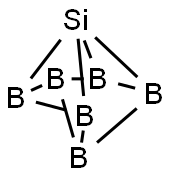HAFNIUM BORIDE
- CAS NO.:12007-23-7
- Empirical Formula: B2Hf-
- Molecular Weight: 200.11
- MDL number: MFCD23713084
- EINECS: 234-500-7
- SAFETY DATA SHEET (SDS)
- Update Date: 2024-12-18 14:15:30

What is HAFNIUM BORIDE?
Chemical properties
gray, hexagonal, crystal(s) solid, a=0.3141 nm, c=0.3470nm; can be prepared by heating HfO2+C+B2O3; hardness 2900 kgf/mm2; resistivity 8.8μohm· cm; used as a refractory material and as a sputtering target with 99.5% purity to produce films, which may be wear-resistant and semiconducting [HAW93] [KIR80] [CER91]
The Uses of HAFNIUM BORIDE
Hafnium boride is used in wear resistant coatings. It is also employed as a nuclear reactor control rod. Furthermore, it is used in hypervelocity re-entry vehicles like ICBM heat shields or aerodynamic leading-edges. It is useful in the preparation of high temperature composites in conjunction with silicon carbide (SiC).
Properties of HAFNIUM BORIDE
| Melting point: | 3250°C |
| Density | 10.5 |
| form | Powder |
| Specific Gravity | 10.5 |
| color | gray hexagonal, hexane crystals, crystalline |
| Water Solubility | Insoluble in water. |
| Crystal Structure | Hexagonal |
| Exposure limits | ACGIH: TWA 0.5 mg/m3 NIOSH: IDLH 50 mg/m3; TWA 0.5 mg/m3 |
| EPA Substance Registry System | Hafnium boride (HfB2) (12007-23-7) |
Safety information for HAFNIUM BORIDE
| Signal word | Warning |
| Pictogram(s) |
 Exclamation Mark Irritant GHS07 |
| GHS Hazard Statements |
H315:Skin corrosion/irritation H319:Serious eye damage/eye irritation H335:Specific target organ toxicity, single exposure;Respiratory tract irritation |
| Precautionary Statement Codes |
P261:Avoid breathing dust/fume/gas/mist/vapours/spray. P305+P351+P338:IF IN EYES: Rinse cautiously with water for several minutes. Remove contact lenses, if present and easy to do. Continuerinsing. |
Computed Descriptors for HAFNIUM BORIDE
| InChIKey | VFOMGQXFCYKNAF-UHFFFAOYSA-N |
New Products
4-Fluorophenylacetic acid 4-Methylphenylacetic acid N-Boc-D-alaninol N-BOC-D/L-ALANINOL Tert-butyl bis(2-chloroethyl)carbamate 3-Morpholino-1-(4-nitrophenyl)-5,6-dihydropyridin- 2(1H)-one Furan-2,5-Dicarboxylic Acid Tropic acid S-2-CHLORO PROPIONIC ACID ETHYL ISOCYANOACETATE 2-Bromo-1,3-Bis(Dimethylamino)Trimethinium Hexafluorophosphate (6-METHYL-[1,3]DITHIOLO[4,5-b]QUINOXALIN-2-ONE INDAZOLE-3-CARBOXYLIC ACID 4-IODO BENZOIC ACID (2-Hydroxyphenyl)acetonitrile 4-Bromopyrazole 5,6-Dimethoxyindanone 2-(Cyanocyclohexyl)acetic acid 4-methoxy-3,5-dinitropyridine 2-aminopropyl benzoate hydrochloride 1-(4-(aminomethyl)benzyl)urea hydrochloride diethyl 2-(2-((tertbutoxycarbonyl)amino) ethyl)malonate tert-butyl 4- (ureidomethyl)benzylcarbamate Ethyl-2-chloro((4-methoxyphenyl)hydrazono)acetateRelated products of tetrahydrofuran








You may like
-
 Hafnium boride powder, 5-10 μm, 99.5% CAS 12007-23-7View Details
Hafnium boride powder, 5-10 μm, 99.5% CAS 12007-23-7View Details
12007-23-7 -
 2033-24-1 98%View Details
2033-24-1 98%View Details
2033-24-1 -
 1975-50-4 98%View Details
1975-50-4 98%View Details
1975-50-4 -
 2-HYDROXY BENZYL ALCOHOL 98%View Details
2-HYDROXY BENZYL ALCOHOL 98%View Details
90-01-7 -
 2-Chloro-1,3-Bis(Dimethylamino)Trimethinium Hexafluorophosphate 221615-75-4 98%View Details
2-Chloro-1,3-Bis(Dimethylamino)Trimethinium Hexafluorophosphate 221615-75-4 98%View Details
221615-75-4 -
 61397-56-6 CIS BROMO BENZOATE 98%View Details
61397-56-6 CIS BROMO BENZOATE 98%View Details
61397-56-6 -
 14714-50-2 (2-Hydroxyphenyl)acetonitrile 98+View Details
14714-50-2 (2-Hydroxyphenyl)acetonitrile 98+View Details
14714-50-2 -
 118753-70-1 98+View Details
118753-70-1 98+View Details
118753-70-1
Statement: All products displayed on this website are only used for non medical purposes such as industrial applications or scientific research, and cannot be used for clinical diagnosis or treatment of humans or animals. They are not medicinal or edible.